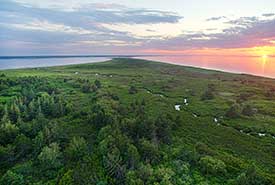Prince Edward Island: A bird’s-eye view

Blooming Point Nature Reserve, PEI (Photo by Mike Dembeck)
A popular destination for both people and birds, Prince Edward Island is a natural treasure in Atlantic Canada. The small island (5,620 km2) is one of the most densely populated provinces in the country. The island holds historical and natural values such as coastal shorelines, estuaries and Wabanaki (Acadian) forests. Its forests and coastal habitats create ideal environments for many species to thrive in. Great blue heron, beaver, eastern coyote, muskrat and red fox are only a few of the species thriving on this magical island.
Most known for its picturesque beaches and potato fields, PEI is also recognized for its diverse population of migratory birds, such as at-risk piping plover, Canada warbler, eastern wood-pewee, olive-sided flycatcher and bank swallow.
The challenges of island life
These at-risk birds have a difficult time navigating the challenges of the human-wildlife interactions and predators. Food scarcity, habitat loss due to development and human-caused effects are the main reasons behind the decline in their population. Additionally, pollution of different kinds can be harmful to the birds. Light pollution at night can confuse birds, making them think that it’s daytime, which in turn causes them to fly into more urban areas where there is a higher risk of predation. Sound pollution in high traffic areas also creates challenges for birds that use sound for navigation, feeding, avoiding predators and mating.
Keeping a watchful eye
Thanks to the longstanding partnership between the Nature Conservancy of Canada’s (NCC’s) PEI conservation team and Island Nature Trust there is hope that bird habitat and survival will improve on the island. Island Nature Trust plays an important role in helping the birds by monitoring all piping plovers outside of the PEI National Park on the island. The PEI team has also invited avid biologists from the provincial forest fish and wildlife division to help with biological survey work in the field.

Canada warbler (Photo by Stephen McGrath)
“Educating the public about at-risk birds and loss of habitat is a great way to help lessen the conditions for these species,” says Hannah MacLean, NCC’s PEI conservation intern. While studying biology at the University of Prince Edward Island, Hannah found that her experience as the only intern on the island has provided a wide variety of opportunities. Some days she is in the field with her team completing bird surveys, other times she works from the office, sourcing data for a variety of projects.
In addition to having a wonderful summer in her hometown, Hannah gets to fulfill her curiosity about wildlife and nature through valuable experiences and fun adventures. A typical day in the field for her involves bird surveying, a procedure of calling birds and collecting data on their numbers and sounds using the Merlin app as a reference tool.
Why bird surveys are an important conservation tool

Great blue heron (Photo by Stephen McGrath)
The best part of bird surveys, besides imitating their sounds to catch their attention, is being able to identify them. Imitating bird sounds is done via official survey techniques and used only for species where visual detection is not possible. “When camping or hanging out with my friends, I often ask if they can hear the bird sounds as well as I do. And they are always shocked at how I can name the birds without seeing them,” says Hannah.
These bird surveys are also great opportunities for birders to get out in nature and help collect data. “When we find species-at-risk, we contribute to larger research being done about why that species may be at risk. Such data helps scientists understand what habitats the birds like and why they may be declining,” explains Hannah.
In their most recent bird survey at the Five Houses Woodland Nature Reserve, the PEI team, with the help of five wonderful volunteers, identified about 22 different species. With binoculars and the Merlin app in hand, the crew spent three hours in the woods, enjoying the presence of the birds and learning about their habitats. The group may have been small, but the work they completed was ever so valuable. “It is as if our team of three is a small but important piece of a puzzle, helping bring awareness to a bigger audience,” says Hannah.
Although all nature reserves on PEI are important to these migratory at-risk birds, the nature reserves below were recently surveyed and the following species were observed:
- Blooming Point Nature Reserve: Canada warbler, eastern wood pee-wee
- Governors Island: bank swallow, great blue heron, double-crested cormorant
- Kwesawe’k (Oulton’s Island): great blue heron, double-crested cormorant
- St. Peter’s Harbour and Lake Run: piping plover
You can make a difference today by supporting projects on PEI and helping protect bird habitats. Learn more.


